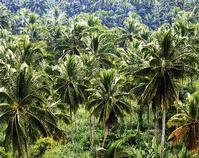Dr. Wayne Myrie, Plant Pathologist, Contributor

Acres of coconut trees in the Bog Walk area of St Catherine.- Ricardo Makyn/Staff Photographer
Lethal yellowing (LY) is a devastating disease that has affected coconut palms in Jamaica since 1884, but before 1961 was confined to the western region of the island. It was first reported in the Cayman Islands in 1834. In 1961, LY suddenly appeared in the Buff Bay area, about 110km from the nearest case in the west. The disease spread rapidly to the east, the principal coconut growing region in the island. In 1971, the entire island was considered a disease area (C.I.B., 1984 and 1985).
By 1980, the disease had been responsible for the deaths of over seven million coconut palms in Jamaica. In the 1980s, the deaths of Malayan Dwarfs at Green Island, Half Moon Hotel and Golf Course, and Bengal Estates in unusual high numbers, indicated that the pathogen was capable of overcoming the resistance of the Malayan Dwarf. By 1981, in other areas, the levels of lethal yellowing mortality for Malayan Dwarf and Maypan were found to be five per cent and 10 per cent respectively (Been, 1999). However, there were pockets adjacent to the coast where mortality levels among populations of Malayan Dwarfs and Maypans were as high as 40 per cent.
Mortality levels
After Hurricane Gilbert in 1988, the incidence of lethal yellowing began to increase. At various points along the coastal areas of the northern region, mortality levels among stands of Malayan Dwarf and Maypan were observed to be consistently higher than anticipated. This pattern persisted into the 1990s and in certain places the disease has started to move away from the coastal areas. In some areas monitored regularly, the data collected was indicating that the infection rate of the disease was increasing significantly.
It was clear from the data that lethal yellowing again became the single most important plant disease affecting the coconut industry of Jamaica. At Hart Hill lethal yellowing, in six years, destroyed all the Malayan Dwarf palms. Similar destruction had taken place in sections of F. M. Jones estates at Darlingford and Williamsfield. The disease has its usual characteristics of being lethal and fast spreading and is affecting many species of palms and different coconut varieties (Myrie, 2002). However, an important difference was observed - lethal yellowing of the 1970s affected mainly bearing trees while the disease of the 1990s and 2000s affects non-bearing coconut trees with greater frequency (Myrie, 2002).
Mycoplasma-like organism
Lethal yellowing is caused by a phytoplasma previously known as mycoplasma-like organism (MLO). Phytoplasma is a prokaryote of the class Mollicutes and is a bacterium that has no cell wall, cannot be cultured, and has a small genome size.
The disease is active in Hispaniola, Turks and Caicos Islands, Cuba, the Bahamas, Florida, Mexico, Belize and Honduras. Similar lethal diseases occur in sections of the West African countries of Ghana, Togo, Cameroon and Nigeria and the East African countries of Tanzania and Kenya (Been, 1999).
The symptoms of LY have been well described over the years by researchers. These are premature shedding of all fruits on the palm, blackening and death of newly emerged and unopened inflorescences, yellowing of older and then younger leaves, root necrosis, collapse of the newly emerged leaf and within the crown soft rot that invariably leads to death of the palm. Infected trees usually die within three to six months after appearance of the first symptoms.
Resistance was first noticed, in the late 1950s, after observations at Round Hill Estate in the West End of the island where red fruited Malayan Dwarfs (grown from seeds obtained from Trinidad) had survived despite continuous exposure to LY.
During the LY epidemic in Jamaica in the 1970s and 1980s, the Malayan Dwarf, a highly resistant variety at the time, was used in replanting programmes across the island.
Lethal yellowing is now the major threat to the continued viability of the local coconut industry. Lethal yellowing of the 'newer' more virulent type that has been destroying Maypans, Malayan Dwarfs and other varieties, continues to be most active at several locations. Most of these locations are near the coast, nevertheless LY is advancing inland.
At present, there appears to be no option for the national programme other than to continue using established Malayan Dwarf-based resistance. Concerted effort is needed to locate and test new sources of resistance as soon as possible.
Management strategies for the control of the lethal yellowing disease include:
Sanitation and weed control.
Weekly monitoring of the coconut farm by grower.
Immediate identification and removal (cutting) of lethal yellowing infected coconut trees.
The infected coconut trees should be immediately removed from the field if possible or be carefully burned.
Replace the removed coconut tree with coconut seedling given by or purchased from the Coconut Industry Board.
Implementation of a good fertilisation programme.
Your Feedback: Do you want to comment on a story? Contact us at mias@uwimona.edu.jm or telephone us at 970-2021 or 512-3067
Fun facts to
know and tell
Coconut oil was the world's leading vegetable oil until soybean oil took over in the 1960s.
The world's tallest grass, which has sometimes grown 130 feet or more, is bamboo.
Banana plants are the largest plants on earth without a woody stem. They are actually giant herbs of the same family as lilies, orchids, and palms.

